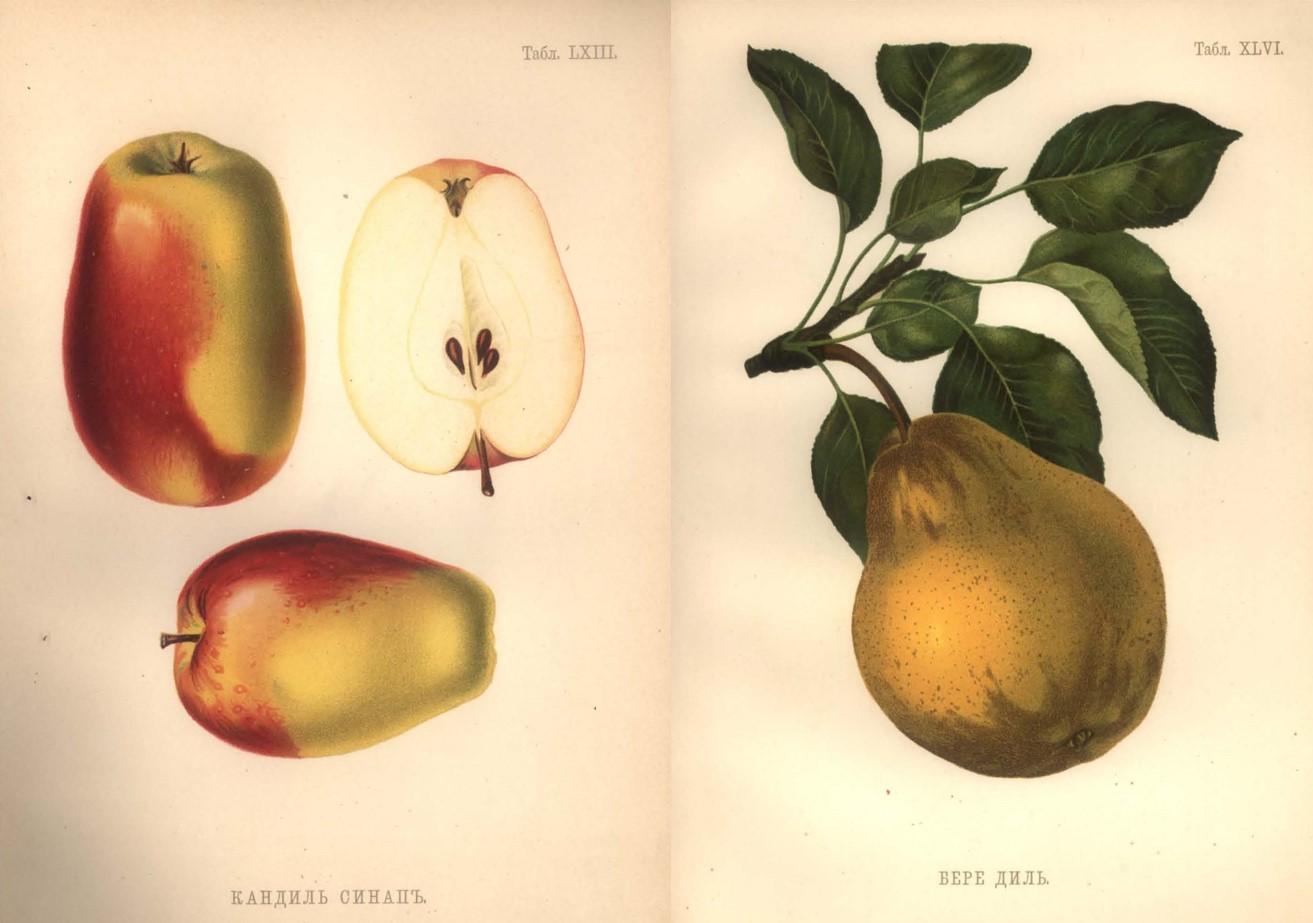We are thrilled to announce the new Gardens of Crimea dashboard!
The building blocks of this dashboard are a set of documents held in the State Archive of the Autonomous Republic of Crimea, and a set of botanical publications held at Harvard Library, the New York Public Library, the Russian Geographical Society, and the Bibliothèque nationale de France. The dashboard covers a long 19th century, from a tree census in 1793 to the publication of an Atlas of Fruits in 1906. It includes image galleries, datasets, glossaries, and maps. We can't wait for you to dig in, but first we thought it would make sense to explain why gardens matter.

“There can be no doubt about the significance of fruit cultivation for Russia.”
V. V. Pashkevich, official at the Department of Agriculture of the Russian Empire
Vasilii Vasil'evich Pashkevich (1856–1939), editor of a landmark study of commercial fruit cultivation, did not mince words. This was his opening line, and he designed it to make an impression.
Pashkevich was a scientist. He had trained at home and abroad and had been entrusted with the task of compiling what was, essentially, a botanical encyclopedia of the entire empire. His declarative statement echoed through the halls of the ministry, the academy, and the local agricultural societies that dotted the provincial landscape in 1896.
But what if, despite Pashkevich's authority, a doubt were to linger about the significance of fruit cultivation? What if someone somewhere were to ask, however tentatively, “Eh hem, just a moment—why is it I should bother studying the differences between apple varieties or learning where fig trees were cultivated two centuries ago? Why, exactly, does orcharding matter?”
Why indeed?
Reason #1: Its (relative) success is a measure of modernization.
In a sense, the significance of fruit is timeless: a fresh, sweet, pear is delicious no matter what the century. But the cultivation, distribution, and consumption of fruit has most certainly changed over time.
Those changes garnered a lot of attention at the turn of the twentieth century as states grew obsessed with agricultural production. As populations rose and shifted from farms into towns—across the Russian Empire this phenomenon began after the emancipation of the peasants in 1861—state and commercial actors innovated ways to meet new demands for food.
Hungry workers were more likely to rebel over bread than apples. Agricultural experts were aware that fruit was a newcomer on the scene. They explained that until recently, “owing to the sparse population of towns and the want of convenient ways of communication, vegetables and fruit did not have any great trade importance, and were principally cultivated for the use of the growers themselves.” (This passage comes from a text prepared by the Ministry of Agriculture and State Domains for the World Columbian Exposition in Chicago in 1893.)
Even in the absence of a mature fruit market, most inhabitants of the empire had access to at least some form of seasonal fruit. The rough geography was simple: apples and cherries in the north, pears, plums, apricots, grapes, nuts, and peaches in the south. Dig a little deeper, of course, and you will turn up a menu of regional specialties. St. Petersburg and Novgorod were known for berry culture (gooseberries! strawberries! currants!). Mogilev prided itself on the Antonovka apple. Poltava was famous for its plums.
The expansion of the empire changed this geography.
During the reign of Alexander I (1801–1825) it became obvious that the center of gravity had shifted to the south and southwest—into much of modern-day Ukraine and Moldova. Suddenly cultivators in Podolsk and Bessarabia were exporting thousands of tons of dried plums, and Tavrida Province became the indisputable hub of fruit production. The soil and climate of southern Crimea in particular were conducive to the sought-after French varieties of apple and pear, and neither the August storms nor the “noxious insects” that threatened production could dampen the spirits of orcharding enthusiasts.
Eager gardeners could purchase saplings and learn grafting techniques at local nurseries. Well-maintained orchards yielded thousands of silver rubles in annual profits. Thousands of cartloads of pears and apples traveled north through Perekop to the markets of Kherson, Kharkov, and Moscow. In towns small and large, those with means fell head over heels for the taste of Crimea.
Map Interlude!
In 1895, the Department of Agriculture published a map of the Russian fruit industry. Pan, zoom, and move your cursor over the map to reveal the explanatory notes.
But even a bumper crop of gorgeous, dessert-quality fruit was worthless if it stayed in the orchard. The value of the most brilliant apple depended on the quality of roads, access to horses, and the appetite of carters for work and wages.
The functional-but-vulnerable distribution networks that brought fruit to market on a halting, irregular, and expensive, basis changed dramatically in the latter part of the nineteenth century. Railroads get most of the credit for industrialization in the late tsarist period and for good reason—slashing the travel time from Simferopol to Moscow from fourteen days to two was a game-changer in the transportation of perishable cargo like plums and cherries.
The value of the most brilliant apple depended on the quality of roads, access to horses, and the appetite of carters for work and wages.
But railroads weren’t the only engines of change. When it comes to fruit, it is tough to overstate the importance of the growth of canning factories, novel drying technologies, and the development of new product lines. Kolomna grew famous for its pastila (pressed fruit confection), Rzhev (near Tver) for its syrup. Thanks to both industrial development and commercialized agriculture, fruit took on new significance as the foundation of a proliferation of candies and confections crafted to please the modern palette.
Reason #2: It was good business.
The development of new technologies of preservation and transportation followed a tectonic shift in the imperial economy. The emancipation of the serfs in 1861 caused a precipitous fall in fruit production. The loss of labor on large estates—the source of most marketed fruit—came just as demand for fresh and dried fruit in the growing towns of the empire skyrocketed.
Just how precipitous was this precipitous drop? The fruit crop was notoriously difficult to measure, but officials were sure that domestic production did not come close to meeting demand. Their most compelling piece of evidence? The fact that in the 1880s, Russia imported over three million rubles worth of apples, pears, and dried fruits each year. Clearly there was revenue and profit to be gained from increased production.
Revenues depended on all sorts of variables, from rainfall and wind speed to pests and labor. There was also the question of quality. Fruit that fell from the tree prior to harvest was far cheaper than harvested fruit; wild fruit was cheaper than cultivated fruit. Among the cultivated varieties some were suited for canning or drying, while the best of the best served as “table” or “dessert” fruit. Fruit was sold fresh, dried, boiled, pickled, canned, or as preserves. Some varieties were interchangeable; others enjoyed effective branding. The famous Antonovka apple, for example, was in demand because of its suitability for cooking and confections, while the most prized winter dessert apples in the entire empire were the unmistakable Sary Sinap and Kandil Sinap from Crimea.

Illustrations of the Kandil Sinap apple and Bere Dil pear.
Profits could be measured in fruit weight, but the famous botanist Lev Platonovich Simirenko preferred to calculate rubles per tree. He found, in 1912, that Crimean apple trees each generated between four and six rubles in profit, with French varieties generating roughly twice the profit of “Tatar”—or local—varieties. The bigger the orchard, the greater the profit, but even small spaces—and most Crimean gardens were small—held value.
The outlook, on the eve of world war and revolution, was promising. At least from the local perspective.
Reason #3: The fruit market was global. And cutthroat.
One of the components of the Gardens of Crimea dashboard is the “Glorious (Fruit Tree) Glossary.” It shows, in vivid color, that no tree, no matter how limited its distribution, existed outside the ordered space of the Linnaean classification system. As botany took root (pun intended) across Europe in the eighteenth century, dictionaries and journals and guides and studies poured from the printing presses. The biggest names worked in Belgium, Prussia, and France, but Russia produced its own crop of experts, among them Karl Gablits (1752–1821), Adam Stanislavovich Grebnitskii (1858–1941), and Vasilii Vasil’evich Pashkevich.
By the late 19th century however, the center of commercial fruit cultivation had relocated across the Atlantic.
Russian horticulturalists were obsessed with California. The overnight emergence of the American fruit industry was all anyone talked about. Experts attributed it to several factors: dietary preferences, the abundance of cheap suitable land, entrepreneurial courage, participation of a large number of social organizations, and good education. They issued dire warnings of a coming "flood of American fruit into European markets" and advocated means of mitigating the effects of foreign competition.
Russian horticulturalists were obsessed with California.
Protective tariffs alone would not boost domestic production. The Department of Agriculture, with its bevy of botanists, therefore launched a bold campaign: a campaign to convince cultivators to adopt the methods used so successfully in the United States. They organized demonstrations of kiln-drying (as opposed to sun-drying) at the Imperial Agricultural Museum in St. Petersburg in 1886, and then in Moscow, Simferopol, Kharkov, Voronezh, and Derbent. Cheered by the buzz, they arranged exhibitions of fruit wine and cider production.
In 1894 St. Petersburg hosted the International Exhibition of Fruit Cultivation. A special department of the Ministry of Agriculture and State Properties was set up to handle the affair. They produced a map of fruit production (see the map interlude above!). They published glossy brochures. They arranged lectures. They sponsored tastings of wine and dried fruits. They encouraged schools to include gardening techniques in their curricula.
Despite these herculean efforts, at century's end officials were disconsolate. They complained that the fruit industry suffered not just from ignorance of cutting-edge techniques, but from the absence of something as simple as a logical plan that assigned each tree variety to the region best suited to its cultivation. Even more embarrassingly, Russians seemed to suffer from a “general confusion” about the names of fruits let alone their commercial value. While Californians were establishing large-scale orchards over thousands of acres, Crimeans had yet to abandon the traditional half-wild diminutive gardens that created an irregular patchwork across the peninsula.
The (Historical) Value of Gardens
The story does not end here. And it is not a tale of backwardness and woe.
True, the Russian fruit market went from boutique to robust between 1800 and 1900 while the fruit industry struggled to keep pace. In a world growing more modern by the day, success was measured in terms of productivity and profit.
Had diversity and longevity carried as much weight though, Crimea might have stood toe-to-toe with California on the world stage. And its gardens have a lot to tell us about how information, ambition, and environment shape empires.
Dive into the dashboard to learn more.
Bibliography
Немец, Ярослав. Промышленное плодоводство в Северной Америке. Санкт-Петербург, 1899.
Mescherskii, I. I. “Gardening and Viticulture; Kitchen Gardening and Orcharding,” in Industries of Russia: Agriculture and Forestry with colored maps by the Department of Agriculture Ministry of Crown Domains for the World’s Columbian Exposition at Chicago, vol. III. St. Petersburg, 1893: 183-203.
Обзор деятельности Министерства государственных имуществ (ныне Министерства земледия и государственных имуществ) в царствование Императора Александра ИИИ. 1881-1894 гг. Санктпетербург, 1901.
Пашкевич, Василий Васильевич (редатор). Плодоводство в России: Материалы и исследования, выпуск 1. Санкт-Петербург, 1896.
Симиренко, Лев Платонович. Крымское промышленное плодоводство. Москва, 1912.






